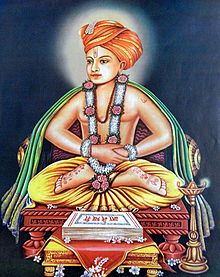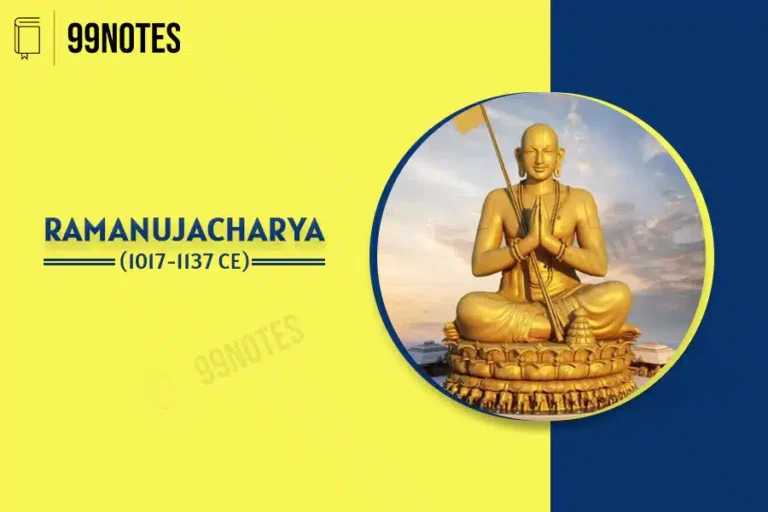Sant Dnyaneshwar (1275–1296 AD): Early life, Spritual Journey, Works, Philosophy & Samadhi
Sant Dnyaneshwar
Sant Dnyaneshwar, a name that resonates with devotion and enlightenment, remains one of the most revered saints in the annals of Indian spirituality. Born in the 13th century, Dnyaneshwar was a Marathi saint, poet, philosopher, and yogi. During Bhakti movement, he has significantly contributed to the Marathi language’s literary and spiritual landscape. His life and works continue to inspire millions, embodying a profound blend of knowledge and devotion. He belonged to the Nath Shaiva tradition. He is one of the founders of the Varkari tradition of Maharashtra. Yadavas of Devagiri ruled Maharastra during his lifetime. He was a contemporary of Namdev, another saint of the Varkari tradition.

Early Life of Sant Dnyaneshwar
Dnyaneshwar was born in 1275 AD in Apegaon village on the banks of the Godavari River in Maharashtra. His parents, Vithalpant and Rukmini, faced societal ostracization due to Vithalpant’s decision to return to a householder’s life after being initiated into sannyasa. This harsh rejection by society deeply impacted the young Dnyaneshwar and his siblings.
The turning point in Dnyaneshwar’s life came when his family was denied the rights to perform religious rituals, propelling him towards a quest for spiritual understanding and societal acceptance.
Spiritual Journey and Teachings
Dnyaneshwar’s spiritual journey began under the guidance of his elder brother, Nivruttinath, who initiated him into the Nath tradition. Embracing the essence of Bhakti (devotion), Dnyaneshwar emphasized a personal relationship with the divine, accessible to all, regardless of caste or social standing.
His teachings advocated for a life of simple living, devotion, and the pursuit of knowledge. Dnyaneshwar placed great importance on Nishkama Karma, the performance of duty without attachment to outcomes, and Bhakti as means to attain Moksha (liberation).
Dnyaneshwari / Bhavartha Deepika
“Dnyaneshwari” also known as “Bhavartha Deepika” is Dnyaneshwar’s commentary on the Bhagavad Gita. Written in Prakrit Marathi, it made the philosophical insights of the Gita accessible to the common people. It became a fundamental text of the Varkari sect. Through this work, Dnyaneshwar introduced the Marathi language to profound philosophical discourse, previously limited to Sanskrit.
The “Dnyaneshwari” covers a wide array of themes from devotion and duty to knowledge and liberation, emphasizing the unity of the self with the supreme. The end of the book contains Pasaydan a prayer for the general well-being of the people.
Other Works and Contributions of Sant Dnyaneshwar
Apart from “Dnyaneshwari”, Dnyaneshwar authored “Amrutanubhav“, a text elucidating the philosophy of non-dualism, It covers yoga and philosophy and “Changdev Pasashti“, a set of verses in honor of Changdev Maharaj. His “Haripath” expresses the importance of chanting Lord Hari’s name. These works collectively contribute to the richness of Marathi literature and the depth of its spiritual tradition.
His philosophy:
- Considered to be the first philosopher who wrote in the Marathi language.
- He advocated Non-dualistic Advaita Vedanta philosophy emphasizing Yoga and Bhakti towards Vithoba, an incarnation of Lord Vishnu.
Legacy and Influence
Dnyaneshwar’s teachings significantly influenced the Marathi Bhakti movement, shaping the spiritual landscape of Maharashtra. His life and works inspired a lineage of saints like Namdev, Tukaram, and Eknath, who followed in his footsteps, propagating the Bhakti tradition.
The Varkari Sampradaya, a devotional movement, holds Dnyaneshwar’s teachings at its core, with followers making an annual pilgrimage to Pandharpur, singing abhangas (devotional poems) composed by these saints.
Pandharpur Pilgrimage and Varkari Tradition
The Varkari tradition, deeply influenced by Dnyaneshwar, revolves around the worship of Vithoba, a form of Lord Krishna, with the pilgrimage to Pandharpur being its focal point. Dnyaneshwar’s “Palkhi” (palanquin) procession from Alandi to Pandharpur is a testament to his enduring legacy, drawing thousands of devotees annually.
Dnyaneshwar Maharaj Samadhi
Dnyaneshwar took Samadhi in Alandi at the tender age of 21, leaving behind a legacy of devotion and wisdom. His Samadhi site is a place of pilgrimage, symbolizing the eternal nature of his teachings and spirit.
Conclusion
Sant Dnyaneshwar’s life and works exemplify the union of Jnana (knowledge) and Bhakti (devotion), offering a timeless guide to spiritual seekers. His legacy, embodied in his literary contributions and the Varkari Sampradaya, continues to foster social harmony, spiritual devotion, and philosophical inquiry, making him an eternal beacon of wisdom in the spiritual and cultural heritage of Maharashtra and beyond.







